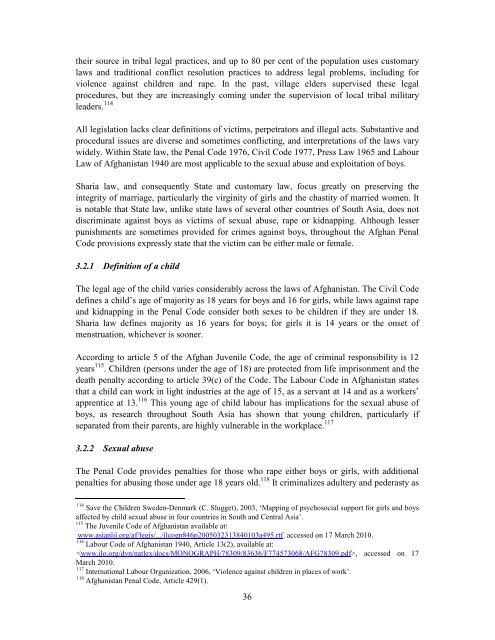SEXUAL ABUSE AND EXPLOITATION OF BOYS IN SOUTH ASIA A ...
SEXUAL ABUSE AND EXPLOITATION OF BOYS IN SOUTH ASIA A ...
SEXUAL ABUSE AND EXPLOITATION OF BOYS IN SOUTH ASIA A ...
Create successful ePaper yourself
Turn your PDF publications into a flip-book with our unique Google optimized e-Paper software.
their source in tribal legal practices, and up to 80 per cent of the population uses customary<br />
laws and traditional conflict resolution practices to address legal problems, including for<br />
violence against children and rape. In the past, village elders supervised these legal<br />
procedures, but they are increasingly coming under the supervision of local tribal military<br />
leaders. 114<br />
All legislation lacks clear definitions of victims, perpetrators and illegal acts. Substantive and<br />
procedural issues are diverse and sometimes conflicting, and interpretations of the laws vary<br />
widely. Within State law, the Penal Code 1976, Civil Code 1977, Press Law 1965 and Labour<br />
Law of Afghanistan 1940 are most applicable to the sexual abuse and exploitation of boys.<br />
Sharia law, and consequently State and customary law, focus greatly on preserving the<br />
integrity of marriage, particularly the virginity of girls and the chastity of married women. It<br />
is notable that State law, unlike state laws of several other countries of South Asia, does not<br />
discriminate against boys as victims of sexual abuse, rape or kidnapping. Although lesser<br />
punishments are sometimes provided for crimes against boys, throughout the Afghan Penal<br />
Code provisions expressly state that the victim can be either male or female.<br />
3.2.1 Definition of a child<br />
The legal age of the child varies considerably across the laws of Afghanistan. The Civil Code<br />
defines a child’s age of majority as 18 years for boys and 16 for girls, while laws against rape<br />
and kidnapping in the Penal Code consider both sexes to be children if they are under 18.<br />
Sharia law defines majority as 16 years for boys; for girls it is 14 years or the onset of<br />
menstruation, whichever is sooner.<br />
According to article 5 of the Afghan Juvenile Code, the age of criminal responsibility is 12<br />
years 115 . Children (persons under the age of 18) are protected from life imprisonment and the<br />
death penalty according to article 39(c) of the Code. The Labour Code in Afghanistan states<br />
that a child can work in light industries at the age of 15, as a servant at 14 and as a workers’<br />
apprentice at 13. 116 This young age of child labour has implications for the sexual abuse of<br />
boys, as research throughout South Asia has shown that young children, particularly if<br />
separated from their parents, are highly vulnerable in the workplace. 117<br />
3.2.2 Sexual abuse<br />
The Penal Code provides penalties for those who rape either boys or girls, with additional<br />
penalties for abusing those under age 18 years old. 118 It criminalizes adultery and pederasty as<br />
114 Save the Children Sweden-Denmark (C. Slugget), 2003, ‘Mapping of psychosocial support for girls and boys<br />
affected by child sexual abuse in four countries in South and Central Asia’.<br />
115 The Juvenile Code of Afghanistan available at:<br />
www.asianlii.org/af/legis/.../jlcogn846p2005032313840103a495.rtf, accessed on 17 March 2010.<br />
116 Labour Code of Afghanistan 1940, Article 13(2), available at:<br />
, accessed on 17<br />
March 2010.<br />
117 International Labour Organization, 2006, ‘Violence against children in places of work’.<br />
118 Afghanistan Penal Code, Article 429(1).<br />
36










